Results 1 to 1 of 1
Thread Information
Users Browsing this Thread
There are currently 1 users browsing this thread. (0 members and 1 guests)
-
05-19-2015, 04:07 PM #1
Why does Barclays want to build a city in the middle of the New Mexico desert?
Why does Barclays want to build a city in the middle of the New Mexico desert?
Santolina, a planned 38,000-home mega-development on the outskirts of Albuquerque, has got local residents deeply concerned that it will suck up desperately needed water amid warnings of a future megadrought

One of the existing suburban developments in the desert outside Albuquerque; beyond the city limits, land is cheaper and taxes are lower. Photograph: Trekshots/Alamy
Claire Provost and Loren Bienvenu in Albuquerque
@claireprovost
Tuesday 19 May 2015 04.32 EDTLast modified on Tuesday 19 May 201508.30 EDT
The southwestern US state of New Mexico is anything but crowded. Spread across an area larger than the United Kingdom, this desolate state has a population of just two million. A quarter of that is concentrated in its largest city, Albuquerque – a small metropolis dwarfed by its vast desert surroundings.
It is a scenic yet drought-ridden land of tans and ochres, interrupted only by the occasional drab green cactus or sagebrush. Even the Rio Grande, which courses through the city, is brown.
The banks alongside the river paint another picture, however. A lush ribbon of green runs from the north of the city through Albuquerque’s South Valley, where generations of farmers have been irrigating small parcels of land in much the same way as their Spanish ancestors hundreds of years before them, coaxing life out of the arid desert soil. Compared to the city or the drylands around it, this semi-rural slice of Albuquerque can feel a world unto itself, dotted with small ranches and family farms.
Lorenzo Candelaria, 69, has lived in the South Valley all his life, working a four-acre plot of land he says has been in the family since the late 1600s. On his farm, the sound of chickens clucking and dogs barking mixes with the hum of lawnmowers from a nearby suburb and the roar of an aeroplane overhead.
The loss of our water would be the loss of our culture and self-identity. It’s who we are, not a passing hobby
Lorenzo Candelaria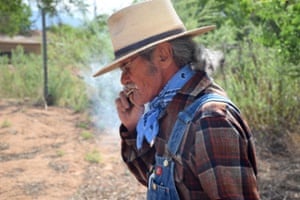 FacebookTwitterPinterest
FacebookTwitterPinterest
Lorenzo Candelaria’s four-acre plot of land has belonged to his family since the late 1600s. Photograph: Brooks Saucedo-McQuade
Like most farmers in the American southwest, Candelaria has been hard-hit by the historic drought consuming the region. But the increasing scarcity of water is compounded by an orchestrated pattern of urban sprawl that Candelaria says imperils his very way of life. In recent years, one threat has loomed larger than the rest – a bizarre mega-development backed by the British bank Barclays, which proposes to build an entirely new city in the middle of the desert, just west of Albuquerque.
The plan, to fabricate a “master-planned community” for nearly 100,000 people on what is today a field of sand dunes, is called Santolina. If fully populated, the development would be about the size of New Mexico’s current second-largest city, Las Cruces, and bigger than Santa Fe, the state capital.
Plans for the project sketch out what looks like a completely self-contained city with open spaces, schools, offices, a town centre and multiple “villages” clustered around the urban core.
It would stretch 13,700 acres or 55 sq km across the desert, making it larger than the UK cities of Cambridge or Ipswich.
And the twist is that this massive community in the centre of New Mexico, just a 10-minute drive from downtown Albuquerque, would exist on land owned and developed by Barclays.
Plans for a mega-development here, alongside the historic Route 66 highway, have been in the works since before the financial crisis. But when the recession hit, more than 21 projects run by SunCal, the real-estate company that had bought the land in 2007, went bankrupt. Barclays, which had been a lender to SunCal, foreclosed on this property; then, with two other investors, set up a new entity, Western Albuquerque Land Holdings (incorporated in Delaware), to take on the development itself.
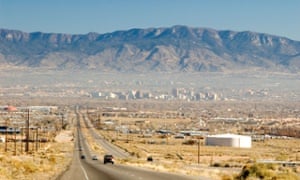 FacebookTwitterPinterest
FacebookTwitterPinterest
The historic Route 66 highway leading into Albuquerque, with the Sandia Mountains beyond. Photograph: Alamy
For Barclays, this is a strategy to make this huge swathe of desert holdings profitable. Santolina’s developers say it’s a project that will help deal with long-term growth in the Albuquerque region over the next several decades: “While infill may accommodate some of the growth, other options are required,” says the development’s website, pointing to estimates that the area’s population will increase by more than 400,000 by 2040. But critics question these projections and say the development is not needed: in the 12 months to 1 July 2014, the Albuquerque metro area grew by just 0.1%, adding only 1,242 people.
Local residents are also deeply concerned that Santolina will suck up water from the Rio Grande river basin that is desperately needed by the community; it is projected to consume upwards of 12 million gallons of water every day, in an area where every drop is already fiercely contested.
“This development would come at the expense of precious water use for farmers and irrigators and people who live here,” says Virginia Necochea, 42, director of the local Center for Social Sustainable Systems, and part of the Contra Santolina group of farmers, organisations and community groups, which have united in opposition to the project. “We’re talking about someone else’s pipe dream at the expense of our communities.”
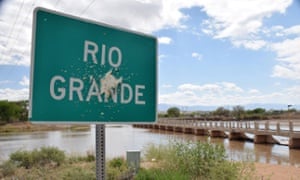 FacebookTwitterPinterest
FacebookTwitterPinterest
The dwindling Rio Grande river supports agriculture in much of the southwest. Photograph: Brooks Saucedo-McQuade
Local water authorities have said they can meet the projected supply needs of the Santolina development. “As long as Santolina is a responsible steward of the resource, we would not anticipate a detrimental ‘impact’ to the area in terms of water supply,” said David Morris of the Albuquerque Bernalillo County Water Utility Authority. He added that the authority has asked for the county’s approval of Santolina to be contingent on strict conservation and water-reuse measures.
But members of the Contra Santolina group remain unconvinced amid warnings that New Mexico is facing a “megadrought” worse than anything experienced in the last 1,000 years. A study released in February by researchers at Columbia University’s Earth Institute points to 2050 as a time when the drought will begin to worsen dramatically, right around when Santolina planners predict the development could approach full capacity.
In Albuquerque’s semi-rural South Valley, where more than 20% of residents live below the poverty line, water is priceless, explains Santiago Maestas. “This is the poorest place in the area. We suffer from poverty, failing schools, gangs, drug abuse, but we do have one great resource – our land and water ... This is our legacy for our children, and our future.”
Maestas, 67, is the president of the South Valley Regional Association of Acequias. He also holds the position of Mayordomo, a traditional role of agricultural leadership that dates as far back as the centuries-old irrigation system. This network of communal, gravity-fed irrigation ditches – called acequias – allows farmers to draw an allotted amount of water from the acequia that adjoins their property. The acequias themselves draw water from a series of larger canals diverted from the Rio Grande.
Despite the tradition held in this ancient system, in the interests of sustainability, more and more farmers are implementing modern practices to meet the changing environment. “We’ve been irrigating our fields for hundreds of years, and we depend upon that water for our existence,” Maestas says. “We’ve been able to survive by adapting.” Now, instead of flood irrigating, many farmers use drip systems that reduce water waste by an estimated 80%.Water is a human right. When we commercialise it for needless housing developments, it’s a crime
Lorenzo Candelaria
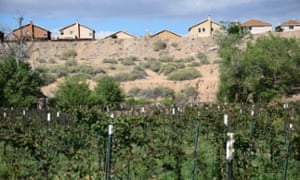 FacebookTwitterPinterest
FacebookTwitterPinterest
New suburban neighbours in Albuquerque’s semi-rural South Valley overlook Lorenzo Candelaria’s farm. Photograph: Brooks Saucedo-McQuade
“The loss of our water would be the loss of our culture, the loss of our self-identity,” says Candelaria, walking through the fields where he grows everything from onions to blue corn. Dressed in overalls and a straw hat, a faded bandana tied around his neck, he outlines what’s at stake. “It’s who we are, not a passing hobby. Four hundred, 500 years is a long time to have a hobby.”
Though rich in history and culture, Albuquerque is perhaps best known internationally as the backdrop to the TV series Breaking Bad, which charts the rise and fall of a methamphetamine manufacturer and showcases the grisly underside of the city. Lying in the middle of one of America’s poorest states and with a population of under 600,000, Albuquerque is overshadowed by the Sandia Mountains to the east, which look down on the city’s modest skyline and glow purple at sunset. Rolling desert stretches out in all other directions.
Like many American cities, as Albuquerque spread outward in the mid-20th century, its downtown fell into decline and many historical buildings were demolished to make way for high-rise office blocks and parking lots. Because land is cheaper and taxes lower outside of the city limits, sprawl has been the dominant paradigm.
Necochea says Santolina represents an antiquated, unsustainable model. “We’re not anti-growth country bumpkins,” she insists. “It is demanded of us, globally, that we be better stewards of the Earth. Developments like these are outdated and we have to change our own behaviours.”
Paul Lusk, former principal planner for Bernalillo County and the City of Albuquerque, agrees, calling the plan “a vestige of 20th-century thinking”. He says it represents “the same dot-dot-dot housing, greenlawn, drive-to-work development that got us into this ongoing, environmentally degrading pattern of separated land use.”
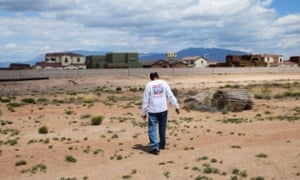 FacebookTwitterPinterest
FacebookTwitterPinterest
Mesa del Sol resident Dean Savas tours the desolate land he says is supposed to be a park. Photograph: Brooks Saucedo-McQuade
Santolina is not the first mega-development that has sought to take advantage of the surplus of inexpensive, bare desert land in New Mexico. Just across the highway to the east of the South Valley lies another giant master-planned community called Mesa del Sol. In 2007, after the project broke ground, its director of economic development described it as “building a city from scratch”. The plans are comparable to Santolina, with space for 38,000 homes, a town centre and walkable streets designed following New Urbanism principles. It would cover an area of about 50 sq km, spread across a flat-topped mountain where many of the bleaker outdoor scenes of Breaking Bad were shot.
To date, fewer than 200 homes are occupied in this mostly undeveloped city-to-be – about half of one percent of its potential final size. Ranging in price from $150,000 to more than $400,000 (the average house price in Albuquerque is around $200,000), the homes are set along a handful of streets, some of which terminate abruptly after the final house. This detached micro-neighbourhood feels eerily tranquil and out of place, almost as if a tornado had whisked a few blocks off a newly built suburb and dropped them precariously atop the mountain.
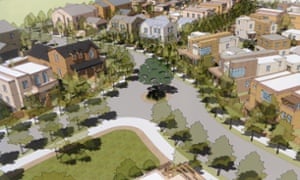 FacebookTwitterPinterest
FacebookTwitterPinterest
An artist’s rendering of the finished Mesa del Sol community. Photograph: Zuma Press/Alamy
Some residents say Forest City and Covington Capital, the developers behind Mesa del Sol, have reneged on numerous promises, leaving new homeowners feeling trapped in a community that does not live up to expectations. “We’re being held hostage,” complains Dean Savas, 60, sitting in his living room in the sparsely inhabited development. Not far from his front door is a weed-strewn patch of dirt he says is supposed to be a park.
Joanie Griffin, spokesperson for Mesa del Sol, defended the development, which she said was “intentionally slowed” after the financial crisis and the decline in the national and local housing markets. “Mesa del Sol is a contrast to sprawl as it is technically an infill project in an area with more than adequate connectivity to the airport, downtown, uptown and the heart of this great city.”
Across the American southwest, the real-estate boom and bust of the 2000s left numerous mega-projects unfinished. Some stand almost entirely empty. Others have paved roads and other infrastructure, but no houses. A few exist only on paper. A 2014 report by the Lincoln Institute of Land Policy thinktank called these “arrested developments” and “zombie subdivisions”, noting that some of these projects still require road and other maintenance but do not contribute to local taxes as planned.
Researchers at the University of Denver, in Colorado, say the problem of zombie subdivisions is particularly sharp in the west of the US, “where land is abundant, and where it was common for local governments to grant development rights well in advance of market demand for housing.”
Last year, an investigation by a local news station found more than 100,000 undeveloped residential lots in the Albuquerque metropolitan area alone, many empty after failed plans by the Amrep Corporation to develop within Rio Rancho, a suburban-area-turned-city that adjoins Albuquerque. Loose sand and debris fill empty lots along the edge of Rio Rancho’s Loma Colorado masterplanned community.
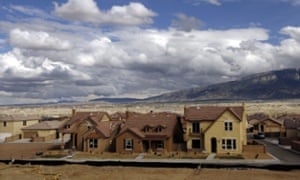 FacebookTwitterPinterest
FacebookTwitterPinterest
‘It’s almost as if a tornado has whisked a few blocks off a newly built suburb and dropped them in the desert.’ Photograph: Andy Nelson/Getty Images
But it’s not just an American story. Before the global financial crisis, new residential developments were popping up at an incredible speed in Europe, as well. Figures collated by the Guardian last year revealed that more than 11m homes lie empty across the continent – enough to house all of Europe’s homeless twice over. Spain, Ireland and Portugal, in particular, are littered with abandoned or failed ghost developments.
In New Mexico, proponents of the Santolina project insist it is “cohesive, well designed and sustainable” and will benefit the wider area. A spokesperson for Barclays said Western Albuquerque Land Holdings “is committed fully to working with Bernalillo County on every aspect of the planning, development and execution of the Santolina plan. The goal for the Santolina development is to create a community that will bring long-term growth for the local economy through employment, housing and industry in Bernalillo County.”
The Santolina project is still going through the local planning process. In March,protesters from around the state arrived outside a county commission hearing on tractors, carrying signs saying “El Agua es la Vida – Water is Life”. An advisory board recommended approving the first stage of the masterplan, but the County Commission has not yet voted, and will hear further appeals at a hearing on 28 May.
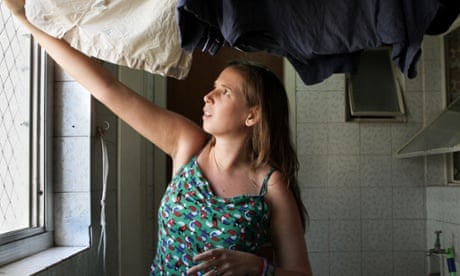
São Paulo – anatomy of a failing megacity: residents struggle as water taps run dry
Members of the Contra Santolina group say their worries extend beyond the events of that day, however. They point out that Santolina is just one of a series of proposed mega-developments on Albuquerque’s horizon referred to as “the string of pearls” – including two others on land owned by Barclays.
Not many miles from where the commission meets to shape the region’s future, Lorenzo Candelaria walks through tangled rows of blackberry bushes to the irrigation canal on which his crops depend. He says there is too much at stake with projects like Santolina. “It’s OK to share [water], because it’s God-given. It’s a human right. But when we commercialise it for needless housing developments, it’s a crime.” As he speaks the canal roars in the background, at its annual peak due to the snowmelt running off northern New Mexico’s warming alpine peaks.
The sound of rushing water reassures Candelaria even as he questions how long it will last. “When I’m really troubled, I come here. It speaks volumes about who we are, and who I am.”
http://www.theguardian.com/cities/20...wl-albuquerqueNO AMNESTY
Don't reward the criminal actions of millions of illegal aliens by giving them citizenship.
Sign in and post comments here.
Please support our fight against illegal immigration by joining ALIPAC's email alerts here https://eepurl.com/cktGTn
Similar Threads
-
Will international terrorists help U.S. build Greater Middle
By AirborneSapper7 in forum Other Topics News and IssuesReplies: 0Last Post: 07-14-2011, 12:13 AM -
UN Blueprint: Dismantle Middle Class, Build World Government
By Newmexican in forum General DiscussionReplies: 1Last Post: 10-02-2010, 08:53 AM -
A desert city that didn't fan out
By JohnDoe2 in forum Other Topics News and IssuesReplies: 0Last Post: 08-13-2010, 09:26 PM -
Ford to build Fiesta subcompact near Mexico city
By FedUpinFarmersBranch in forum Other Topics News and IssuesReplies: 9Last Post: 05-31-2008, 06:28 PM -
City police hope Mexico trip helps officers build trust here
By Brian503a in forum illegal immigration News Stories & ReportsReplies: 0Last Post: 07-08-2006, 12:59 PM


 LinkBack URL
LinkBack URL About LinkBacks
About LinkBacks




 Reply With Quote
Reply With Quote


Durbin pushes voting rights for illegal aliens without public...
04-25-2024, 09:10 PM in Non-Citizen & illegal migrant voters